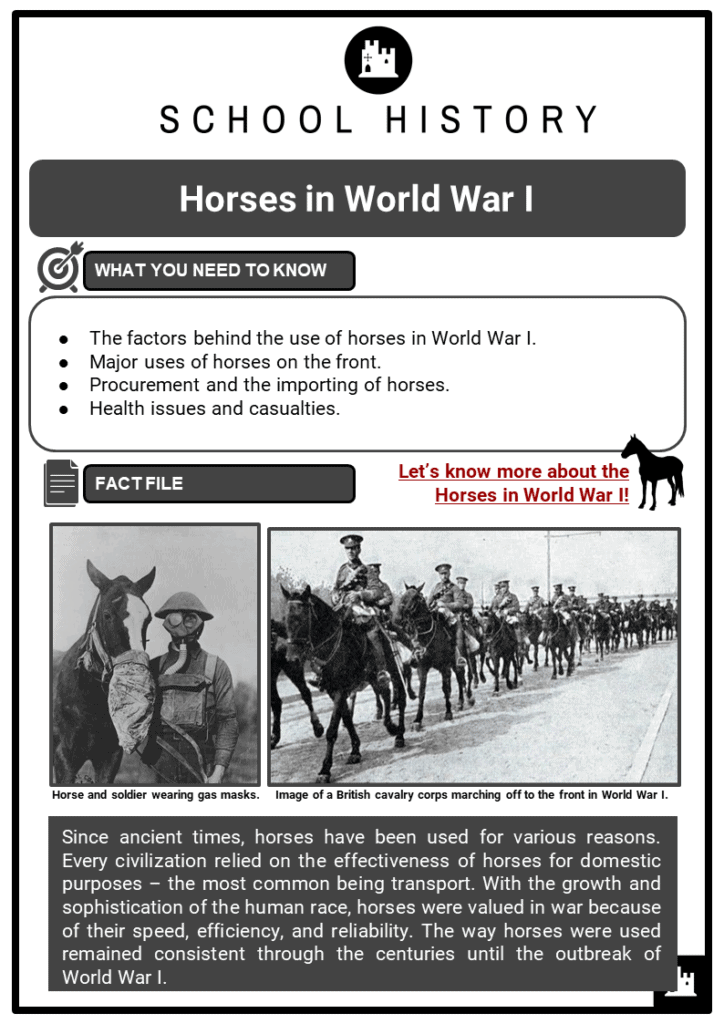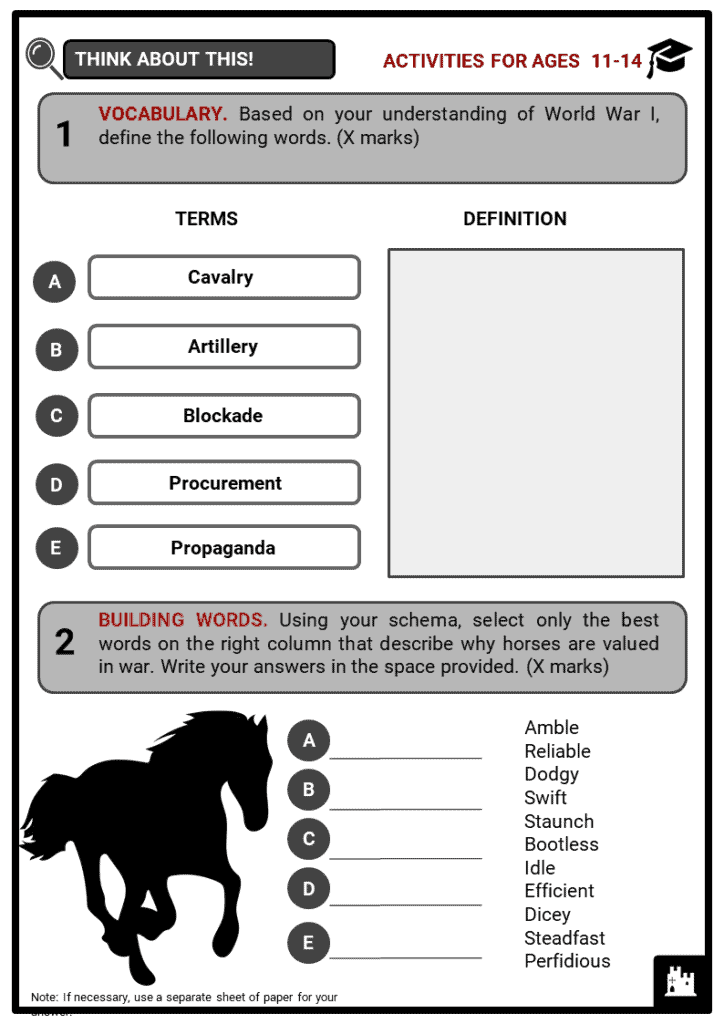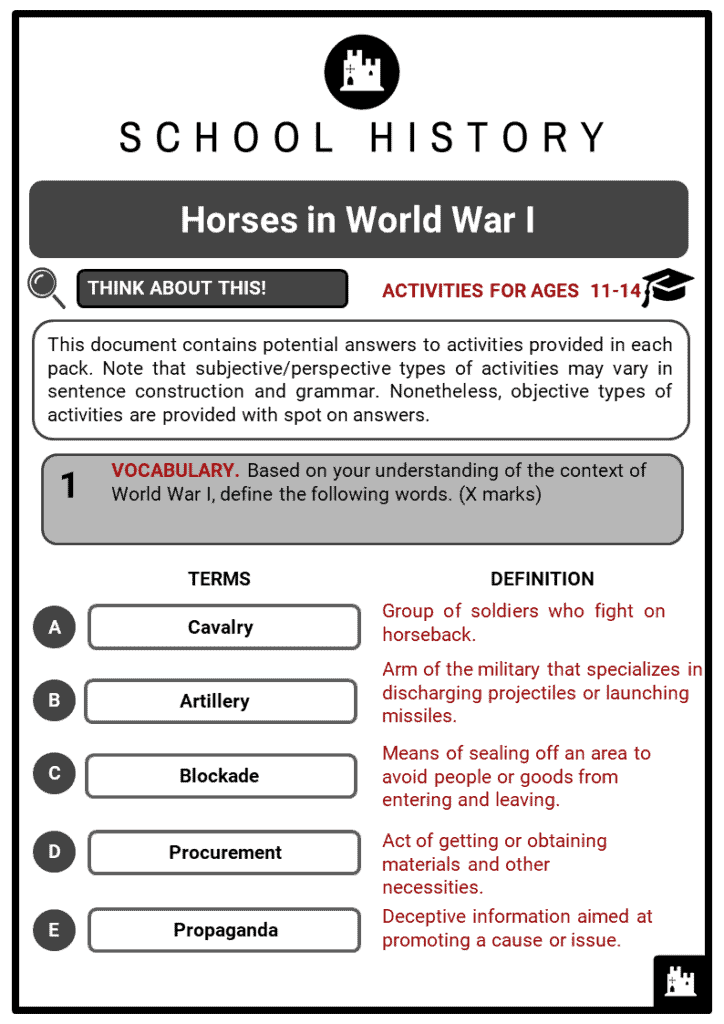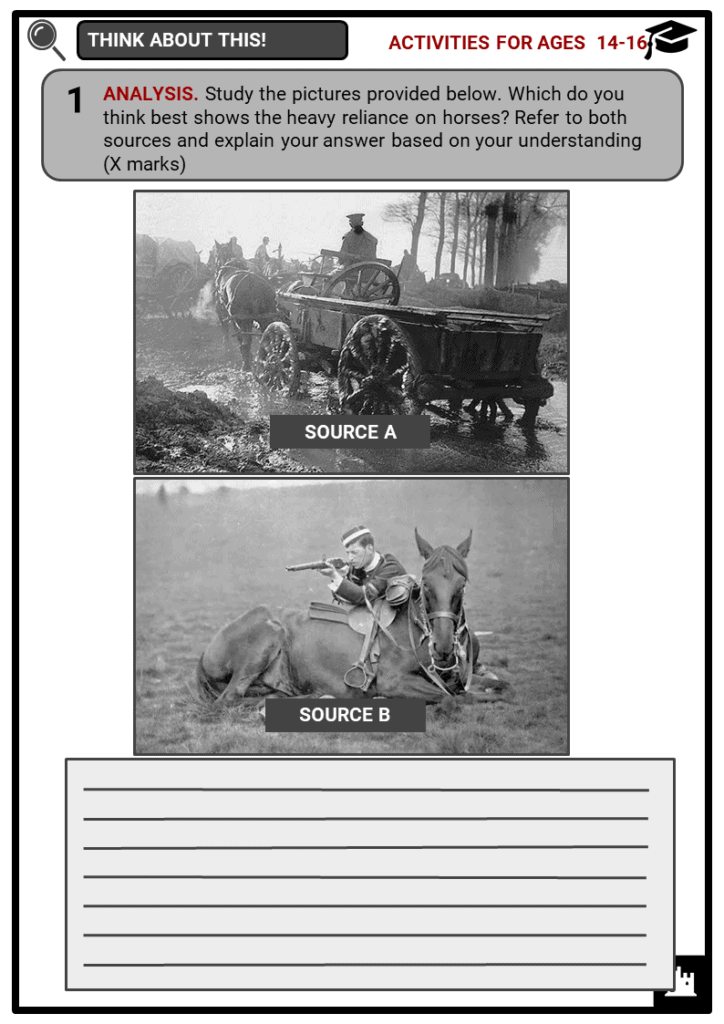Download Horses in World War I Worksheets
Do you want to save dozens of hours in time? Get your evenings and weekends back? Be able to teach Horses in World War I to your students?
Our worksheet bundle includes a fact file and printable worksheets and student activities. Perfect for both the classroom and homeschooling!
Table of Contents
Add a header to begin generating the table of contents
Summary
- The factors behind the use of horses in World War I.
- Major uses of horses on the front.
- Procurement and the importing of horses.
- Health issues and casualties.
Key Facts And Information
Let’s know more about the Horses in World War I!
- Since ancient times, horses have been used for various reasons. Every civilization relied on the effectiveness of horses for domestic purposes – the most common being transport. With the growth and sophistication of the human race, horses were valued in war because of their speed, efficiency, and reliability. The way horses were used remained consistent through the centuries until the outbreak of World War I.
The factors behind the use of horses in World War I
- Humans and animals have lived together for centuries. For practical reasons, mankind established a dynamic relationship with animals based on behaviours which were essential for the well-being of both parties. Although it is a general belief that people are fond of animals, there are instances from the past where mankind has misused or abused animals for their own advancement, including the ordeal of horses in World War I.
- The use of horses in World War I attests to the transition to modern warfare. Although the First World War saw the emergence of modern mechanised war machines and vehicles, the traditional use of horses in war was still viewed as indispensable in terms of tactical and strategic advantage, considering that horses were:
- known for their long association with martial tradition, since they were an integral part of every war
- essential and reliable in hauling materials and other goods as demonstrated by their endurance
- loyal and dependent to people, given the fact that they are domesticated animals
- In military terms, horses paved the way for the formation of mobile cavalry regiments. Both Britain and Germany had a cavalry force that numbered 100,000 men when the war broke out in Western Europe in August 1914. Each cavalry force required a large number of horses. Most senior military personnel during that era believed in the supremacy of the cavalry attack. In August 1914, when the war took a turn for the worse, no one could have foretold the horrors of trench warfare, hence cavalry regiments were considered superior.
- As a matter of fact, the cavalry regiments would have been seen as the greatest regiment in the British army and superior to the guard regiments. Many senior army positions were also held by cavalry officers.
Major uses of horses on the front
- Horses in military action
- Horses were heavily relied upon in the First World War. The military used horses in both logistical support and military operations, and the early battles of World War I were fought with cavalry forces.
- Horses were first involved in the war in a British cavalry attack against the Germans near Mons, Belgium in August 1914. It was the last cavalry charge on the Western Front.
- Such charges were rendered impractical and simply not possible due to trench warfare on the Western Front.
- Some cavalry charges were made possible, however. In March 1918, the Germans were attacked by a British cavalry charge.
- By the spring of 1918, out of the 150 warhorses that were used, only 4 survived.
- German machine-gun fire was the main reason that most of the horses did not survive.
- Of the Allied nations, Britain used their cavalry throughout the war while the United States only used theirs for a short time. Of the Central powers, the Ottoman Empire used cavalry extensively throughout the war.
- Horses as transports
- Despite the fact that cavalry charges were no longer a viable military tactic, horses were still crucial as a form of transport, and were used to carry equipment to the battlefronts.
- Horses remained reliable as military vehicles because mechanised vehicles, such as lorries and tanks, were still relatively new inventions and were prone to break down.
- Transport horses were also used in reconnaissance movements, transporting messengers, and for pulling ambulances, artillery, and other supply materials.
- Furthermore, horses and mules required little upkeep compared to lorries and trucks.
- The notion of horses as a means of transportation also promoted the formation of horse artillery units. The artillery units also played an important role in the war by providing mobile fire support to army units on the battlefield.
- Transport Corps (Corps of Transport) was a support arm of the Army tasked with handling all matters pertaining to the transport of men and war materials to the front. As such, the Transport Corps used horses to provide a necessary service to the Army.
- Since the Army relied mostly on horses for transportation, horses had to cope with the tough deep mud which was common in some parts of the front. Horses that became stuck were either left to die or shot.
Procurement and the importation of horses
- Horses were of great necessity during the First World War, and both Britain and Germany used their resources to produce a number of horses to facilitate operations and campaigns on the front.
- Britain solved the shortage in horses by importing a number of them from America and New Zealand. This enterprise cost the British government £67.5 million. Germany had applied a more elaborate system before the war. In anticipation for the upcoming conflict, the Germans had set up and sponsored horse-breeding programmes in which horses were registered every year like a normal army reservist.
- Due to the blockade imposed by Britain and her allies, Germany was unable to import horses from overseas and this hampered the movements of their army and paralysed artillery battalions and supply lines. Thus Germany stopped using horses soon after the outbreak of the war and began concentrating on trench warfare. In the long run, these factors contributed greatly to the ultimate defeat of Germany.
- From the Americas alone, the British government imported as many as 1,000,000 horses. Most of these were from the United States, Canada, and Argentina.
Health issues and casualties
- Horses were of vital necessity and importance for all armies engaged in World War I. As such, medical care was applied to horses for the purpose of reducing the number of sick and injured animals, and to maintain their good condition despite the fact that they had been subjected to difficult and tough labour. Regardless of these efforts, many horses still died through neglect.
- Since people are fond of horses, army generals believed that the presence of horses on the field would boost the morale of the soldiers - and this fact was also used in recruitment propaganda.
- In reality, horses also suffered horribly alongside the soldiers. In some cases, they were:
- cared for and fed poorly.
- subject to poison gas attacks that injured their respiratory systems and skin.
- victims of skin conditions such mange
- With the invention of gas masks by both Allied and Central nations, horse nose plugs were improvised to help horses in the event of a gas attack.
- Types of gas masks were developed for the use of horses, but some horses destroyed them, mistaking them for feed bags.
- Veterinary hospitals were built to help horses recover from shell shock and battle wounds, but thousands still died and lined the roads of the Western Front. Britain’s Army Veterinary Corps included 27,000 men and 1,300 veterinary surgeons. During the war, the British Army Veterinary Corp hospitals in France received 725,000 horses and more than three-quarters of them were treated successfully.
Health issues and casualties
- In order for the horses to reach veterinary hospitals, they were transported from the front by various forms of transport, including foot and rail. During the last months of the war, barges were considered ideal transportation for horses suffering wounds from shells and bombs.
- A theory developed by soldiers was that less well-bred horses would perform better than their well-bred counterparts. They believed that the latter would be shell-shocked and would act up when exposed to the sights and sounds of war, whereas the former would lie down and take cover at the sound of artillery fire.
- About 20lb of food was fed to British horses, a fifth less than recommended by veterinary doctors. Horse fodder was the single largest import to Europe during the war.
- Disease was also a major concern for horses at the front due to their exposure to the harsh environments that they were moving in.
- Among the known diseases that afflicted many horses were:
- influenza
- ringworm
- sand colic
- sores from fly bites
- anthrax
- Horses presented their own health hazard by making the trench conditions worse. Horse manure acted as breeding grounds for disease-carrying insects.
- A known fungal infection of the skin usually found on horses. The ringworm can spread from horse to horse, and can affect humans.
- Veterinary hospitals treated over two and a half million horses, with about two million being sufficiently cured and cleared to return to duty.
- During the war, more than 8 million horses died in battle. In addition, a considerable number of mules and donkeys also perished. These horses and other animals not only died from the horrors of shelling and bombardments but also due to the appalling weather conditions and the shortage of food.
- The British Army alone lost 15% of their horses annually and a small portion of these were killed by poison gas. Losses affected all sides and by the end of war, the animal shortage was severe. New Zealand veteran Bert Stokes said that in 1917 “to lose a horse was worse than losing a man because after all, men were replaceable while horses weren’t at that stage.”
- During the war, many horses also died because of:
- exhaustion
- drowning
- becoming mired (stuck in the mud)
- falling into shell holes.






